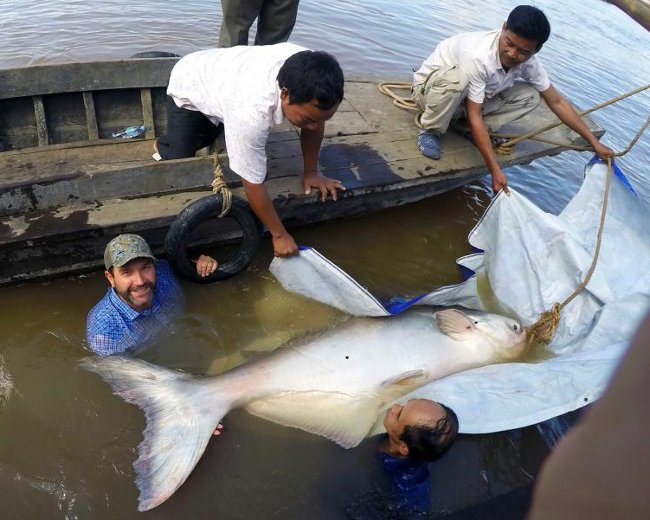Catch the rare giant catfish on the Mekong River
The huge giant gray catfish in North America caught the question of Cambodian fishermen on the Mekong River.
In early November, a group of Cambodian fishermen unexpectedly caught a giant catfish in the Mekong River. This is the first time this fish has appeared in Cambodia for a year.
Zeb Hogan, a biologist specializing in fish research at the University of Nevada, USA, is a fisherman who checks and marks the fish. Fishing on the river near Phnom Penh, the fish is over two meters long and weighs about 90 - 114kg.
"It's not a big category for giant Mekong catfish, but it's still bigger than any catfish caught in North America in the last century , " Hogan said.
The largest catfish in North America so far weighs 65kg, net in North Carolina in 2011. But this size is quite modest compared to the giant catfish caught in Thailand in 2005, which has weight. 293kg and 2.7 meters in length.

The giant catfish is over two meters long.(Photo: University of Nevada).
As the name suggests, the Mekong giant catfish lives on the Mekong River system in Southeast Asia. They are the world's largest scaly freshwater fish and named "fish emperors" in the region because of their size and importance to the local culture.
"This catch is very interesting because it shows that this endangered and extremely rare species still exists in the river. They migrate annually from Tonle Sap Lake to the Mekong to spawn" , Hogan said.
In the 1800s, thousands of giant Mekong catfishes were captured every year. The number of these species decreased by 95% due to overfishing, pollution and habitat destruction. Only a few fish are found in the habitat for a year.
The killing of giant catfish is strictly prohibited, but a series of large dams that grow on the river can destroy the habitat of this fish."If all the giant catfish spawning sites are above the dam, they might fall into extinction," National Geographic quoted Hogan, who has been studying fish for 20 years.
In order to better understand the behavior of the fish, Hogan and the Cambodian Ministry of Fisheries staff attach a plastic card to it. If the fish was caught again, the team could better understand its journey. Fish can live for over 60 years and provide data for a period of time.
Hogan dives to a depth of three meters to release the fish. According to his account, it quickly swam away with good health.
- Giant monster fights are about to perish on the Me Kong line
- 11 species of giant fish are in danger of extinction
- Catch the super monster, must use 4 people
- The dam will make the Mekong catfish extinct
- Hydroelectric dams change the flow, the 'water monster' Mekong is on the verge of extinction
- Sent to giant gold catfish
- Giant fish of the Mekong River
- Giant catfish died deadly due to drought in Thailand
- Admire the rare species of the Mekong
- Video: The girl uses her hand to catch giant catfish
- Vam Nao and the interesting anecdote about the 5-legged crocodile
- New discovery of the process of forming the Mekong River
 Animal 'suffering' after hibernation
Animal 'suffering' after hibernation Why do goats climb well?
Why do goats climb well? Scientists were surprised to see chimpanzees eating turtles
Scientists were surprised to see chimpanzees eating turtles Giant catfish died deadly due to drought in Thailand
Giant catfish died deadly due to drought in Thailand